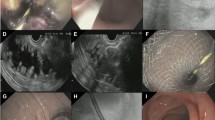Abstract
Background
Techniques and devices for endoscopic ultrasound (EUS)-guided hepaticoenterostomy (EUS-HES) procedures, including EUS-guided hepaticogastrostomy (EUS-HGS) and EUS-guided hepaticojejunostomy (EUS-HJS), have been developed; however, the optimal timing to begin oral intake after EUS-HES remains unknown. This study aimed to evaluate the safety of early oral intake after EUS-HES.
Methods
We retrospectively investigated patients who underwent EUS-HES (EUS-HGS or EUS-HJS) between March 2015 and March 2022. Patients who had no problems with the results of blood tests and computed tomography examinations on the morning of day 1 after EUS-HES were classified as either the early intake group (started oral intake on day 1 after EUS-HES) or the late intake group (started oral intake on day 2 or later after EUS-HES). Patients’ characteristics, procedure characteristics, and early postprocedural adverse events (within 14 days after the procedure) were compared between groups.
Results
Fifty patients were enrolled in this study. Forty-three patients had no problems with the results of examinations performed on the morning of day 1 after EUS-HES. Twenty-one patients comprised the early intake group and 22 comprised the late intake group. Adverse events that developed within 14 days after EUS-HES were not significantly different between groups (early 4.7% vs. late 9.0%; odds ratio, 0.50; 95% confidence interval, 0.0080-10.49; P = 1.00).
Conclusions
Starting oral intake on day 1 after EUS-HES did not increase postprocedural adverse events compared with starting oral intake on day 2 or later after EUS-HES.

Similar content being viewed by others
References
Kim S, Cheoi KS, Lee HJ, Shim CN, Chung HS, Lee H, Shin SK, Lee SK, Lee YC, Park JC (2014) Safety and patient satisfaction of early diet after endoscopic submucosal dissection for gastric epithelial neoplasia: a prospective, randomized study. Surg Endosc 28(4):1321–1329
Park CH, Jung JH, Hyun B, Kan HJ, Lee J, Kae SH, Jang HJ, Koh DH, Choi MH, Chung MJ, Bang S, Park SW (2018) Safety and efficacy of early feeding based on clinical assessment at 4 hours after ERCP: a prospective randomized controlled trial. Gastrointest Endosc 87(4):1040-1049.e1
Kanda Y (2013) Investigation of the freely available easy-to-use software “EZR” for medical statistics. Bone Marrow Transplant 48(3):452–458
Yamamoto Y, Kikuchi D, Nagami Y, Nonaka K, Tsuji Y, Fujimoto A, Sanomura Y, Tanaka K, Abe S, Zhang S, De Lusong MA, Uedo N (2019) Management of adverse events related to endoscopic resection of upper gastrointestinal neoplasms: review of the literature and recommendations from experts. Dig Endosc 31(Suppl 1):4–20
ASGE Standards of Practice Committee, Chandrasekhara V, Khashab MA, Muthusamy VR, Acosta RD, Agrawal D, Bruining DH, Eloubeidi MA, Fanelli RD, Faulx AL, Gurudu SR, Kothari S, Lightdale JR, Qumseya BJ, Shaukat A, Wang A, Wani SB, Yang J, DeWitt JM (2017) Adverse events associated with ERCP. Gastrointest Endosc 85(1):32–47
Isayama H, Nakai Y, Itoi T, Yasuda I, Kawakami H, Ryozawa S, Kitano M, Irisawa A, Katanuma A, Hara K, Iwashita T, Fujita N, Yamao K, Yoshida M, Inui K (2019) Clinical practice guidelines for safe performance of endoscopic ultrasound/ultrasonography-guided biliary drainage: 2018. J Hepatobiliary Pancreat Sci 26(7):249–269
Ochiai K, Fujisawa T, Ishii S, Suzuki A, Saito H, Takasaki Y, Ushio M, Takahashi S, Yamagata W, Tomishima K, Hisamatsu T, Isayama H (2021) Risk factors for stent migration into the abdominal cavity after endoscopic ultrasound-guided hepaticogastrostomy. J Clin Med 10(14):3111
Mandai K, Uno K, Yasuda K (2018) Relationship between the intraperitoneal stent length in endoscopic ultrasound-guided hepaticogastrostomy and surgically altered upper gastrointestinal anatomy in patients with malignant biliary obstruction. Gastroenterology Res 11(4):305–308
Author information
Authors and Affiliations
Corresponding author
Ethics declarations
Disclosures
Drs. Koichiro Mandai, Takato Inoue, Ryo Shinomiya, Takaaki Yoshimoto, Tomoya Ogawa, Koji Uno, and Kenjiro Yasuda have no conflicts of interest or financial ties to disclose.
Additional information
Publisher's Note
Springer Nature remains neutral with regard to jurisdictional claims in published maps and institutional affiliations.
Rights and permissions
Springer Nature or its licensor (e.g. a society or other partner) holds exclusive rights to this article under a publishing agreement with the author(s) or other rightsholder(s); author self-archiving of the accepted manuscript version of this article is solely governed by the terms of such publishing agreement and applicable law.
About this article
Cite this article
Mandai, K., Inoue, T., Shinomiya, R. et al. Safety of early oral intake after endoscopic ultrasound-guided hepaticoenterostomy. Surg Endosc 37, 3449–3454 (2023). https://doi.org/10.1007/s00464-022-09835-1
Received:
Accepted:
Published:
Issue Date:
DOI: https://doi.org/10.1007/s00464-022-09835-1




